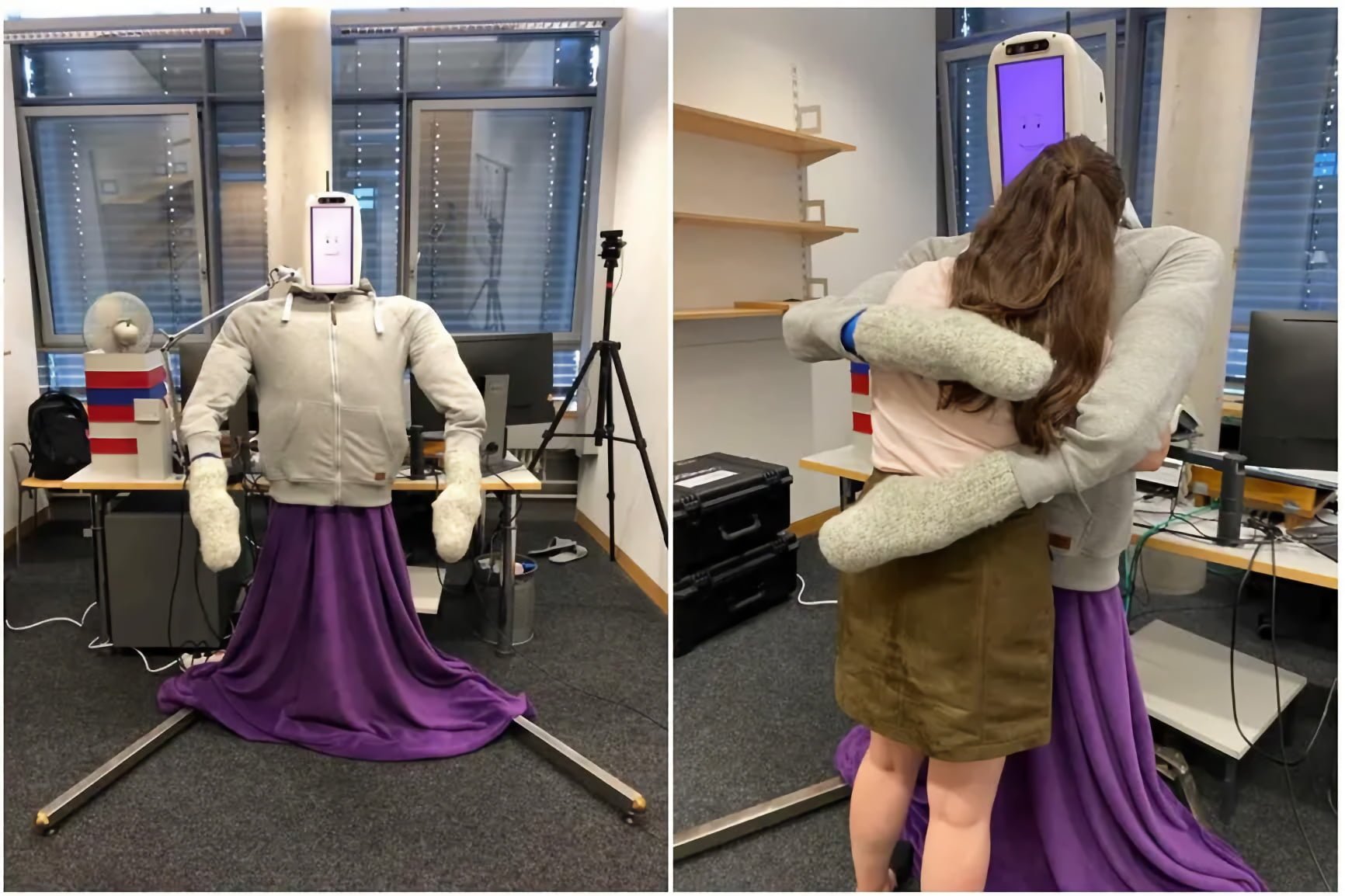HuggieBot 3.0: Robot to learn the perfect hug

The HuggieBot robot distributes hugs. The latest version now learns human hugging preferences.
Humans like hugs. This particular form of physical contact exists all over the world, and if no other human is around, the pet, a stuffed animal or a pillow will be hugged instead.
A hug involves more than a mere passing of arms – at least it should. Humans use their arms and hands to squeeze, rub or pat their counterparts on the back in various intensities. A new robot can recognize some of these gestures and is designed to create an enjoyable hugging experience – without breaking ribs.
HuggieBot for emotional support
Researchers at the Institute for Haptic Intelligence at the Max Planck Institute for Intelligent Systems in Stuttgart have been developing the HuggieBot robot for several years. Version 3.0 is now available. The first version was presented in 2018 and served as a test to find out which hugs people particularly like.
In the long term, the robot will distribute hugs to people who need them urgently at the moment. "Virginia Satir, a well-known family therapist, was famous for saying, 'We need four hugs a day to survive. We need eight hugs a day to sustain us.' We need 12 hugs a day to grow,'" said first author Alexis Block in an interview with IEEE Spectrum.
Block has been conducting research on robotic hugs since 2016. This research, she said, could one day make the emotional support and health benefits of hugs available to many people – wherever and whenever they need them. The COVID-19 pandemic has brought the importance of the research to the forefront even more, Block said.
HuggieBot 3.0 pushes back
In the new research the HuggieBot team is delving into the intricacies of human hugging as mentioned earlier – "intra-hug gestures," as they call it. In a first run 32 test subjects hugged the HuggieBot 2.0 and rated its reaction. This version is equipped with pressure sensors that can detect the various touches during a hug with an accuracy of 88 percent.
The team used the feedback to develop an algorithm that selects the robot's responses to gestures in real time and drives HuggieBot 3.0. The robot can rub over the back, tap on it and squeeze. Test subjects were overwhelmingly positive about the experience, with some describing the hugs as close to a human one.
"Hugging HuggieBot 3.0 is (in my humble and unbiased opinion) really pleasant," Block also says. However, the team doesn't want to fool anyone; it doesn't feel like a human. However, "You hug a robot, but that doesn't mean it can't be pleasant".
11 commandments for hugging robots
From their research over the past six years, the team derives eleven commandments for huggable robots to prevent potential nightmare scenarios and to provide a nice hugging experience instead:
- A hugging robot must be soft.
- A hugging robot must be warm.
- A hugging robot must be the size of an adult human.
- When a hugging robot initiates interaction, it must independently prompt the user to hug when it detects someone in its personal space. A hugging robot should wait until the user starts walking towards it before closing its arms to ensure a consensual and synchronous hugging experience.
- A hugging robot needs to autonomously adjust its hugging to the size and position of the user's body, rather than hugging in a constant manner.
- A hugging robot must reliably detect and respond to the user's desire to disengage from the hug, regardless of the position of its arms.
- A good hugging robot must sense the user's body size and adjust its arm positions accordingly so that it can comfortably place them around the user at the appropriate body locations.
- It is beneficial if a hugging robot can accurately detect and classify gestures performed on its upper body in real time, regardless of the user's hand position.
- Users like a robot that responds quickly to their hugging gestures.
- To avoid appearing too robotic and to hide inevitable errors in gesture perception, a hugging robot should not attempt to perfectly return gestures within the hug. Instead, the robot should employ a gesture response paradigm that combines the user's preferences with slight variety and spontaneity.
- To make the user feel that the robot is alive and caring, a hugging robot should occasionally give the user unsolicited, proactive affective social touches through hugging gestures.
The commandments bear some similarities to the Turing Test: The ideal HuggieBot doesn't understand what a hug is, but it delivers a convincing hug to humans that simulates the body language dialogue of human hugs.
HuggieBot, of course, cannot experience the embodied emotional experience of a hug, the team said. For that it would need an internal emotional model like humans.
A new version of HuggieBot is already in development: HuggieBot 4.0 comes with improved hug positioning and techniques. It will be compared to human hugs.
For this, volunteers will be put under stress and will then be provided with an active or passive human hug or an active or passive robot hug. Regular saliva measurements will provide information about cortisol and oxytocin levels and thus about the possible positive effects of the different hugs.
AI News Without the Hype – Curated by Humans
As a THE DECODER subscriber, you get ad-free reading, our weekly AI newsletter, the exclusive "AI Radar" Frontier Report 6× per year, access to comments, and our complete archive.
Subscribe now